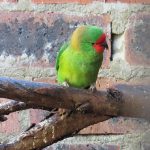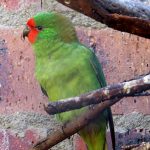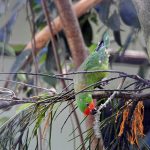LITTLE LORIKEET
Little Lorikeets are small, brightly colored parrots native to eastern and south-eastern Australia, and they are charismatic and beautiful birds, known for their acrobatic flight and their lively and noisy behavior.
They are small parrots, measuring around 17 to 21 cm in length, with a predominantly green plumage, a red forehead and blue crown. Their wings display a combination of green, blue, and black, and their underparts are mostly yellow-green. They have a slender build and a curved beak adapted for feeding on nectar and pollen.
These lorikeets inhabit a variety of habitats, including forests, woodlands, and coastal heathlands. They are particularly associated with flowering eucalyptus trees and are known to undertake seasonal movements in response to the availability of food and nesting sites.
Little Lorikeets are highly social birds and are often seen in flocks that can range from a few individuals to large groups. They are active during the day and spend a significant amount of time foraging for nectar, pollen, and soft fruits. They have specialized brush-tipped tongues that allow them to extract nectar from flowers. They may also feed on insects and their larvae.
Breeding season for Little Lorikeets usually occurs between August and December. They typically nest in tree hollows, often those made by woodpeckers or other parrots. The female lays a clutch of 2 to 3 eggs, which are incubated by both parents for about 18 to 21 days. Both parents participate in caring for the chicks until they fledge, which usually takes around 5 weeks.
Little Lorikeets are classified as a species of “Least Concern” on the IUCN Red List. However, like many parrot species, they face threats such as habitat loss, especially due to land clearing and fragmentation. The availability of suitable nesting hollows is also a concern. Conservation efforts focus on protecting and restoring their habitats, including the preservation of mature trees and the creation of artificial nesting sites.
Observing them in the wild can be a rewarding experience, and their conservation is important to ensure their survival and the health of their ecosystems.



